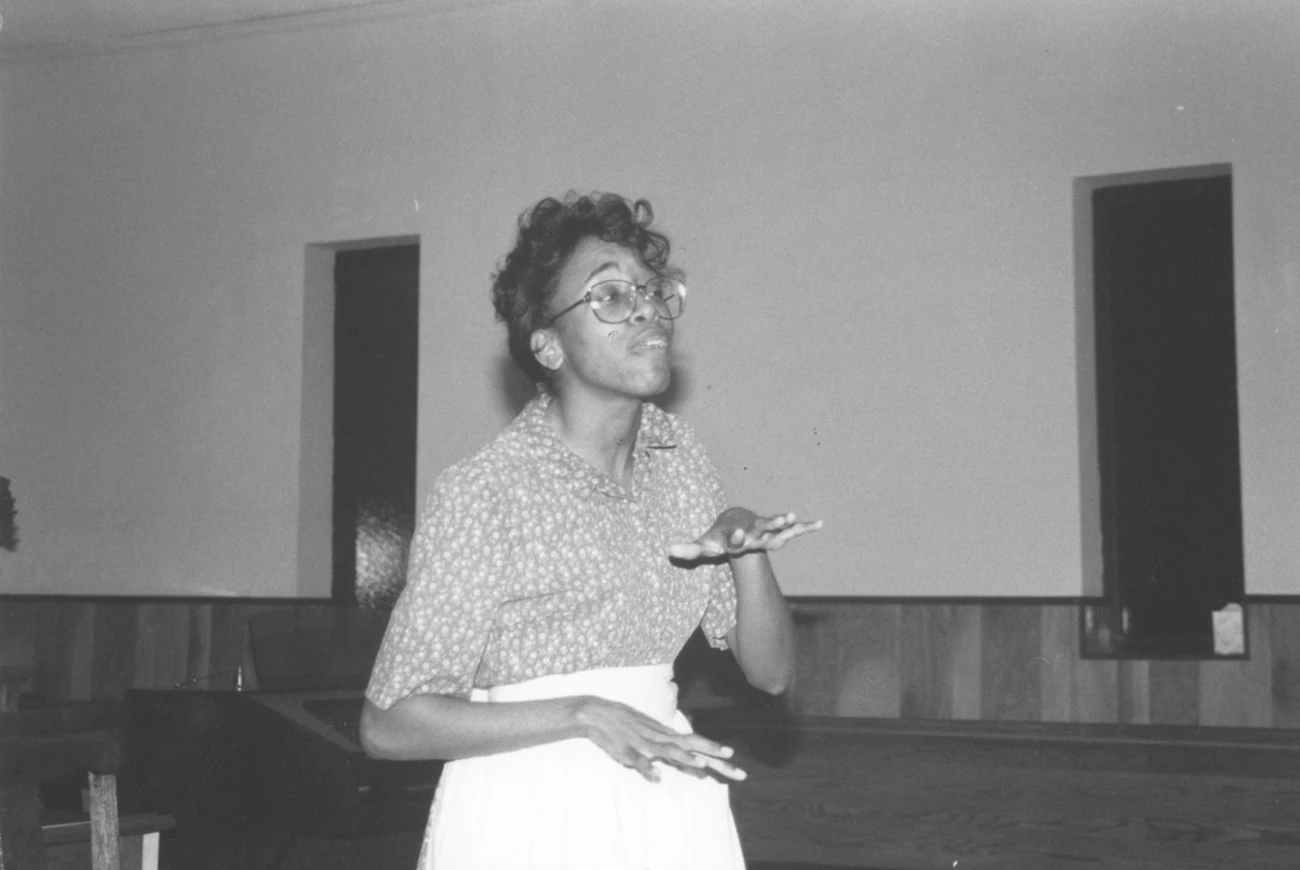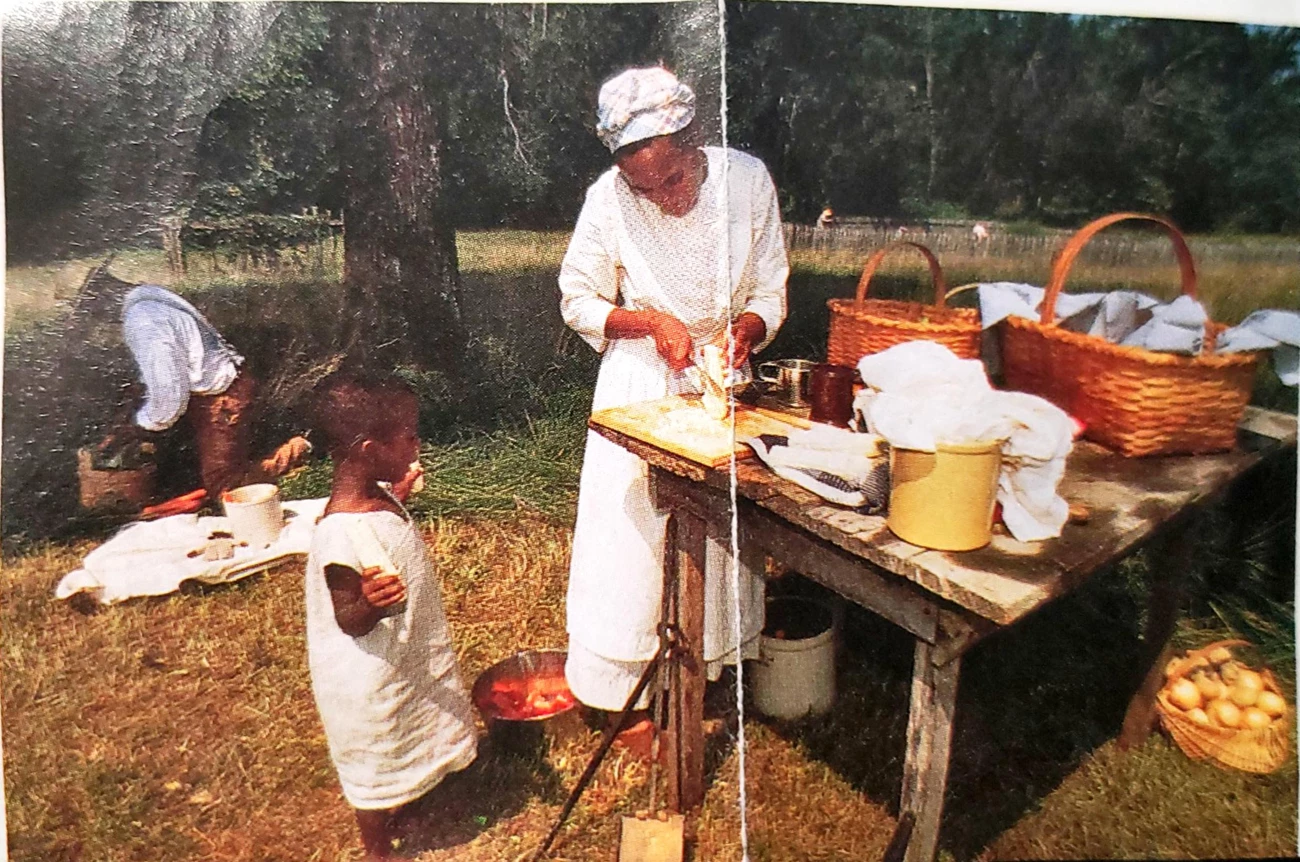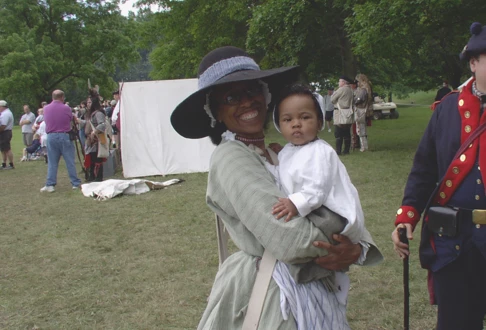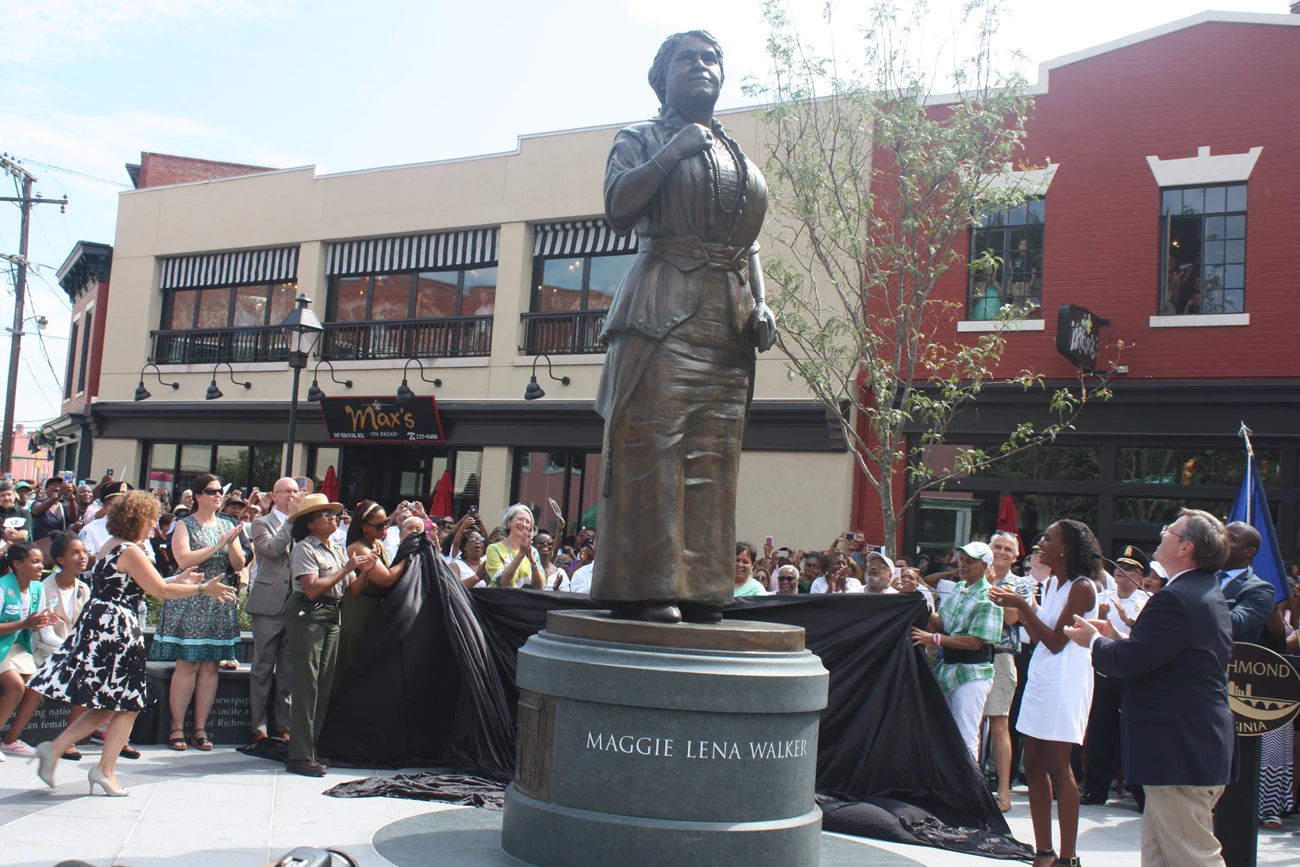Last updated: January 31, 2024
Article
Ajena Cason Rogers: Amplifying Voices of African American Women
This article was developed from two oral history interviews with Ajena Cason Rogers that Lu Ann Jones conducted in October and November of 2020. The interviews are part of two projects: Women’s Voices: Women in the National Park Service Oral History Project, made possible by a grant from the National Park Foundation, and Telling Our Own Untold Stories: Civil Rights in the National Park Service.
Ajena Cason Rogers’s passion for American history is deeply rooted in family history. On her mother’s side are Virginia ancestors like James Apostle Fields. Born into slavery, his family escaped to Fort Monroe in 1863. Following emancipation, Fields thrived as he gained access to education, the vote, and the right to own property. From South Carolina, meanwhile, her father’s parents joined the early 20th century African American migration north to find steady employment in Washington, DC, and the means to invest in their children’s education. Rogers’s parents met at Hampton Institute, now the storied HBCU Hampton University. Little did she know when she joined the National Park Service in 1984 what a source of strength and inspiration her family history would be.
Discovering a Superpower
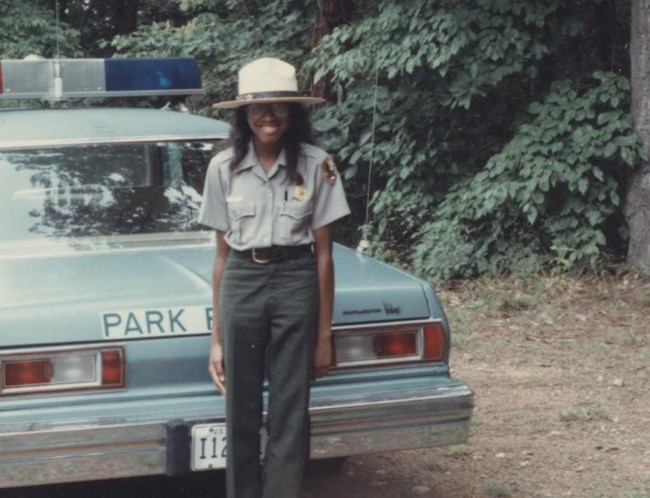
Courtesy of Ajena Rogers
Rogers grew up in Roanoke, VA, near the Blue Ridge Parkway, the first place she worked for the National Park Service. Her primary job was collecting fees at a park campground, but, like many summer seasonal rangers, Rogers got to do a little bit of everything. A co-worker encouraged her to try first-person living history, an interpretation technique that changed her life. When she stood before an audience portraying historical figures, Rogers discovered that her shyness dissolved behind their personas as she spoke on their behalf. “By being somebody else,” she said, “I was brave enough to get in front of the crowd.”
When she created the program “Granny Foster Remembers,” Rogers drew on scholarship about life among Black Appalachians. To her surprise, the research echoed stories she heard at family and church gatherings and the verbal artistry of her Grandmother Cason’s descriptions of growing up in South Carolina. Rogers had an epiphany: “The people who raised me” mattered. “Granny Foster” allowed her to share the wisdom and honor the practices of the women who nurtured her—an experience that moves her still.
-
Ajena Rogers on the "Granny Foster Remembers" program
During an oral history interview with the NPS Park History Program in 2020, Ajena Rogers speaks about recognizing the importance of personal experiences in a park program.
- Credit / Author:
- NPS Park History Program
- Date created:
- 01/14/2022
-
Ajena Rogers: Valued Identities
Ajena Rogers talks about communicating the experience of being Appalachian, African American, and a woman through the Granny Foster interpretation program at Blue Ridge Parkway.
- Credit / Author:
- NPS Park History Program
- Date created:
- 01/14/2022
First-Person African American Interpretation: Pain and Privilege
In 1991, Rogers accepted a permanent job as an interpretive ranger at the Booker T. Washington National Monument, located on the Piedmont Virginia plantation where the future educator was born. An innovative park superintendent encouraged living history demonstrations. As Rogers prepared to portray Jane, Booker’s mother and a cook for the white Burroughs family who owned them, she connected with a growing community of first-person interpreters who were pioneers in living history representations of enslaved people. In the early 1990s, what would become a sea change in African American history was beginning at historical sites not far away. Rogers trained with cutting-edge interpreters at Colonial Williamsburg and drew support from peers.
During Rogers’s tenure, interpretation at the Booker T. Washington National Monument evolved from benign discussions of rural crafts to the hard “emotional history of slavery, race, and racism.” Park rangers asked, How can we portray African American life in the mid-19th century in ways that are relevant to audiences 150 years later?
Rogers answered that question by depicting Jane, who prepared meals over an open fireplace while caring for her young son. Rogers’s own toddler Joe portrayed Booker.
Rogers might have been playing a part, but she discovered the pain of representing an enslaved mother and the power of first-person interpretation. In between interpretive programs, for example, Joe played chase with Amanda, a white girl who portrayed the owners’ granddaughter. When it was time for the program to start, the children had to go their separate ways. Why couldn’t they continue to play together, Joe asked repeatedly.
-
Ajena Rogers and Joe at Booker T. Washington National Monument
In an oral history interview with the Park History Program, Ajena Rogers shares a story about her son and a moment where she felt a connection to the history and people associated with Booker T. Washington National Monument.
- Credit / Author:
- NPS Park History Program
- Date created:
- 01/14/2022
The deep empathy that Rogers felt shook her. And while she could shuck off her costume and escape the character, she knew that Jane and women like her “couldn't do that. I’ve never forgotten that.”
Nor has Rogers forgotten what it felt like when white visitors assumed their own roles and started addressing her as if she were indeed an enslaved woman, not an accomplished woman portraying an historical figure.
-
Ajena Rogers: Roles and Reality in Interpretation
Ajena Rogers describes the challenging role of being an African American interpreter talking to visitors about the experience of someone who is enslaved.
- Credit / Author:
- NPS Park History Program
- Date created:
- 01/14/2022
How did Rogers find relief from the emotional labor of portraying an enslaved woman? She turned to interpreters doing similar work at other sites.
-
Ajena Rogers: "To speak for those that could not speak for themselves"
In an oral history interview, Ajena Rogers described finding strength with other interpreters working at similar sites.
- Credit / Author:
- NPS Park History Program
- Date created:
- 01/24/2022
“What About the People in the Background?”
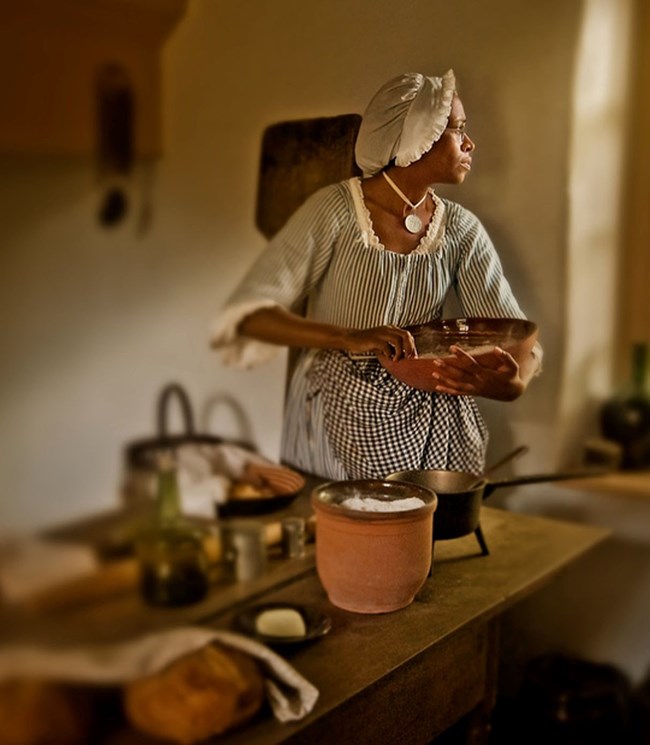
NPS
After Rogers became an interpreter at Valley Forge National Historical Park in 1997, she surveyed primary sources for information about African Americans who served General George Washington and soldiers at the Revolutionary War encampment in Pennsylvania. A visitor’s question nudged her to learn more about “Negro Hannah” and other domestic workers. The visitor asked, “‘What about the people in the background? What about the people that you don’t hear about all the time? Who were the ones keeping the food cooked and cleaning and all of these things?’”
At the time, Rogers couldn’t answer the questions. But she started digging deeper to find information about the woman whose name she finally determined to be Hannah Till, a cook for Washington’s military household. As it turned out, Washington hired Till’s services. Her enslaver pocketed one portion of her pay and Till saved the rest so she could buy her freedom. She succeeded.
Rogers’s costumed interpretation of Hannah Till was popular, and the park decided to film it. On the day of the taping the dynamics of race--past and present--played out once again when her young daughter confided in her.
-
Ajena Rogers: Dynamics of Race, Past and Present
Ajena Rogers spoke about a day when her costumed interpretation of Hannah Till, a cook for General George Washington and soldiers during the Revolutionary War, was being filmed at Valley Forge National Historical Park, presenting an experience of racial dynamics informed by both past and present.
- Credit / Author:
- NPS Park History Program
- Date created:
- 01/24/2022
Finding Her Own Voice
While stationed at Valley Forge, Rogers assumed new responsibilities and sought new opportunities. She took on natural resources interpretation and pursued a master’s degree, all while she juggled the joys and demands of motherhood and being married to an NPS Chief Ranger. Peers recognized her expertise as a living history interpreter of African American life, and she received invitations to speak at professional conferences. Rogers realized that she had something to say in her own voice as well as in the voices of historical figures. She became “more comfortable speaking as a national park ranger” and she had “come to the conclusion that I can’t be quiet. But it was a slow, steady transition over time.”
In 2010 when Rogers became a supervisory park ranger at the Maggie L. Walker National Historic Site in Richmond, the arena for sharing her views grew. She found personal inspiration as she learned more about Walker, the entrepreneur who advocated for civil rights and education for African Americans and women. Rogers came to realize that she shared a “superpower” with Walker—an ability to “negotiate and navigate and get people to come together” to get things done.
-
Ajena Rogers: On Maggie Walker
During an oral history interview, Ajena Rogers shares personal inspiration and qualities that connected her with Maggie Walker. Rogers became a supervisory park ranger at Maggie L. Walker National Historic Site in 2010.
- Credit / Author:
- NPS Park History Program
- Date created:
- 01/24/2022
One of Rogers’s big concerns is the small proportion of NPS staff who are African American. Even at a place dedicated to Black history like the Walker home, at the time of our interview in 2020 she was the site’s sole African American employee. “It should not be that I’m the only Black person on our staff!” She looks to predecessors and her own training for the skills and temperament to create change.
-
Ajena Rogers: "That's why I'm here"
In an oral history interview, Ajena Rogers comments on the privilege and burden of the experiences, training, and opportunities along her path.
- Credit / Author:
- NPS Park History Program
- Date created:
- 02/24/2022
Coming Full Circle
Some three decades after Rogers first directed family stories into the figure of “Granny Foster,” she used living history once again to pay homage to family. After she learned more about her great-great-great-grandmother Martha Ann Fields, on occasion she embodied her as a guest interpreter at Fort Monroe National Historic Site in Hampton, Virginia. The fort is near where, in 1619, colonists forcibly brought the first Africans to British North America. It is also where Union troops accepted “contrabands” who had escaped bondage during the Civil War. Rogers donned period clothing and portrayed Fields, who witnessed three of her children sold and the fourth escape to freedom on his own, then shepherded the remainder of her family from slavery to refuge at Fort Monroe. This time the historical figure was blood kin, and the voice of the interpretive ranger carried on the stories of her ancestors.
More Resources
- Valley Forge Women
- "A Birthplace That Experienced Slavery, The Civil War and Emancipation," Booker T. Washington National Monument
- Maggie L. Walker National Historic Site website
- Sparks, Lisa Vernon. "Descendants of early contraband slaves gather for tribute to ancestors at Fort Monroe". The Daily Press. May 4, 2019.
Tags
- blue ridge parkway
- booker t washington national monument
- maggie l walker national historic site
- valley forge national historical park
- oral history
- interview
- nps employee
- spotlight
- nps careers
- african american heritage
- interpretation
- women's history
- women's voices
- civil rights
- african american history
- women in the nps
- nps history
- ajena rogers

